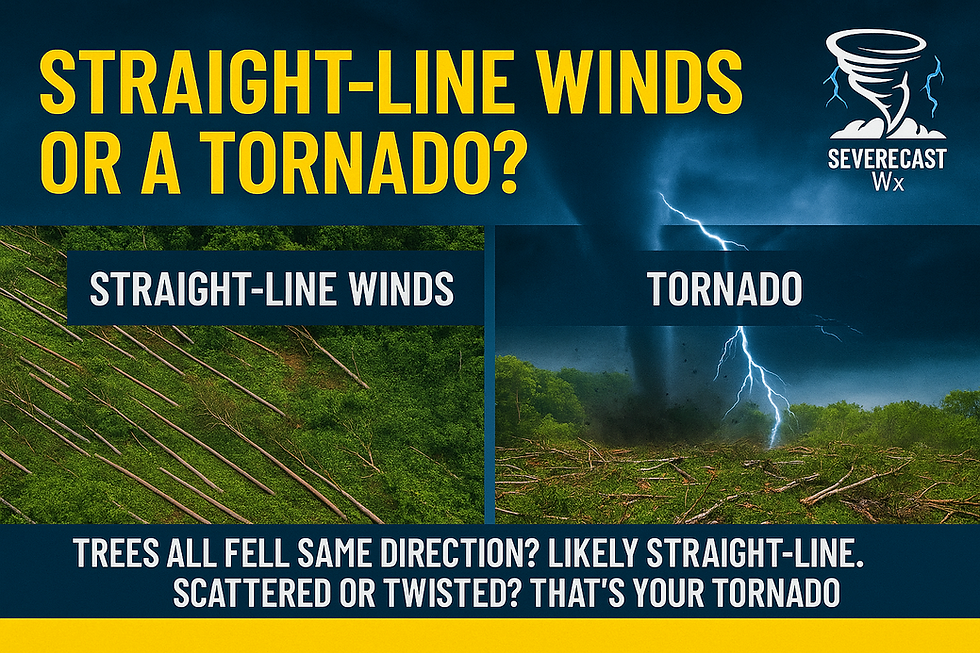Tornado Myths.... BUSTED
- Nicole Carbone
- Apr 19
- 2 min read
Tornadoes are one of the most misunderstood weather phenomena. Over the years, myths have spread—some harmless, others potentially deadly. Let’s bust some of the most common tornado myths and set the record straight to help keep you and your family safe.

1. Tornadoes can’t hit big cities
False. Tornadoes don’t avoid cities—they just cover small areas, making urban strikes less common. But cities like Nashville, Dallas, and even downtown Fort Worth have been hit.
Hiding under a highway overpass is safe
False. Overpasses can funnel winds and debris, making conditions worse. You’re safer in a ditch, low-lying area, or preferably a sturdy building.
Opening windows during a tornado reduces damage
False. This wastes time and may increase danger by allowing debris inside. Go straight to shelter instead.
Tornadoes don’t happen in the mountains, at night, or in winter
False. Tornadoes can form in all terrains and during any time of day or year if conditions are right.
Tornado sirens will always warn me
False. Sirens are meant for outdoor use. You may not hear them indoors, especially while sleeping. Use a weather radio or app for reliable alerts.
A tornado will always be visible
False. Some tornadoes are rain-wrapped or strike at night, making them hard or impossible to see. Don’t wait to visually confirm—take cover immediately when warned.
Tornadoes always move from southwest to northeast
False. Many do, but tornadoes can move in any direction—even backtrack or shift unexpectedly.
Tornadoes only happen in Tornado Alley
False. Tornadoes can and do strike almost all 50 states. “Dixie Alley” in the Southeast can be even more dangerous due to terrain and nighttime activity.
You can outrun a tornado in a car
False. Some tornadoes move faster than cars. Roads can be blocked, traffic can slow you down, and your path may not be safe. Shelter is the better choice unless escape is clear and immediate.
Pressure drop causes houses to explode unless windows are opened
False. Structural damage comes from wind and debris—not pressure. Don’t waste time on windows—get to your safe place.
Only EF4 or EF5 tornadoes are dangerous
False. EF0–EF2 tornadoes can still be deadly, especially without proper shelter. Always take warnings seriously.
Doorways are safe during tornadoes
False. That advice is for earthquakes. In tornadoes, doorways offer no special protection from flying debris or collapsing structures.
Sheltering under heavy furniture is good enough
False. You need more than a couch or table. Put as many walls between you and the outside as possible—ideally in a basement, interior closet, or storm shelter.
The southwest corner of the basement is safest
Outdated. That was older advice. Today’s recommendation is to shelter in an interior corner of the basement, away from windows and under a sturdy structure—but not directly beneath heavy items on the floor above.
Green skies mean a tornado is coming
False. A greenish sky can mean a storm has lots of moisture or hail, but it doesn’t guarantee a tornado. It may signal severe weather, but always trust official warnings—not sky color alone.
Tornado myths can lead to dangerous decisions. The best defense is solid information, good planning, and quick action. When a warning is issued, act fast, not curious. Don’t rely on outdated advice or what the sky looks like. Trust your alerts.





Comments